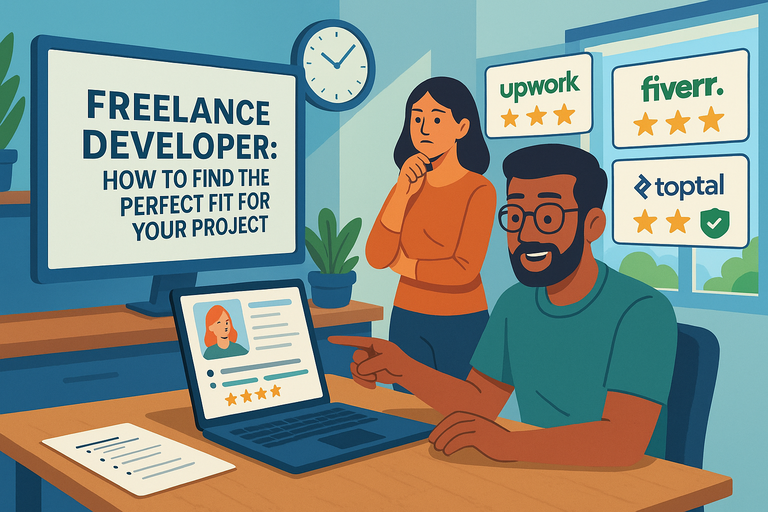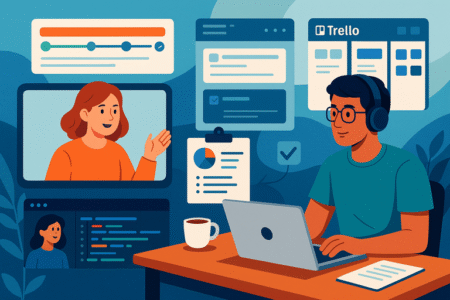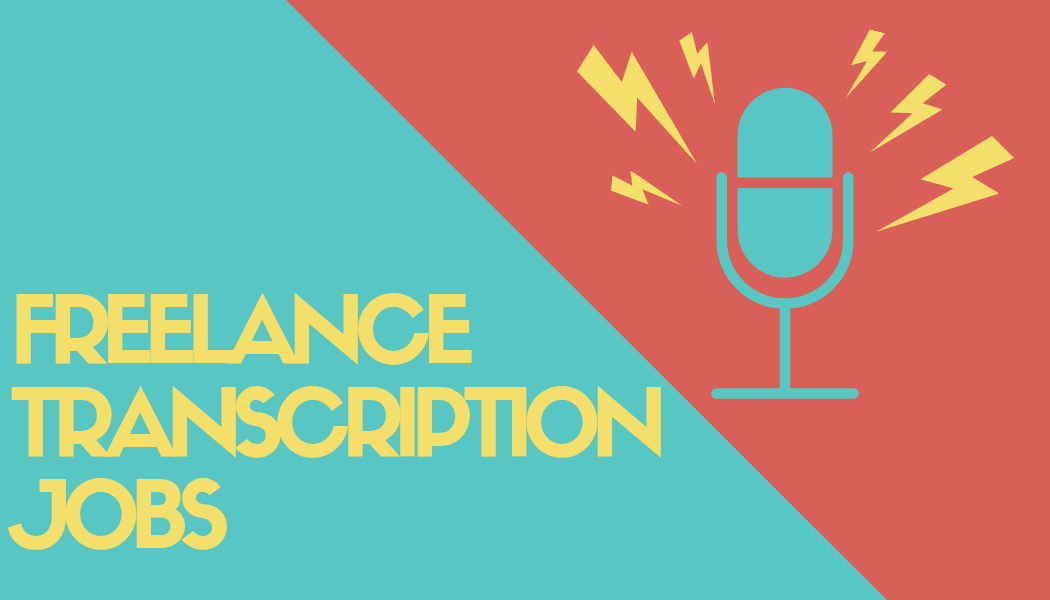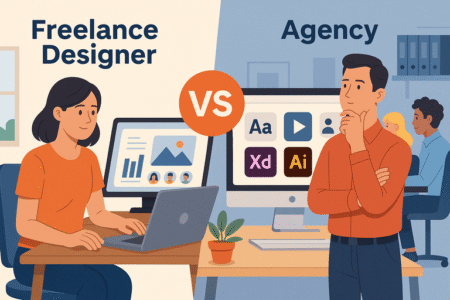Table of Contents
A freelance developer can be the game-changer your project needs, but finding the right one often feels like searching for a needle in a haystack. How do you know if someone has the skills, mindset, and work style to bring your idea to life?
This guide will walk you through the key steps to spot the perfect match and avoid costly mistakes.
Define Your Project Scope Before Hiring
Finding a freelance developer without first defining your project scope is like setting sail without a map — you’ll drift, and it’ll cost you.
Getting clarity upfront not only saves time but also helps you attract the right talent who understands your goals.
Clarify Deliverables and Goals in Writing
Before you even browse profiles or post a job, sit down and write out exactly what you want the freelance developer to deliver. I recommend opening a simple doc and answering these questions:
- What does the finished product look like? (e.g., a mobile app, a landing page, or a backend API)
- How will success be measured? (e.g., “app loads in under 2 seconds” or “website integrates with Stripe”)
- What is the deadline, and what milestones will get you there?
In my experience, being specific reduces miscommunication later.
For example, instead of writing “Build me a website,” say: “Develop a 5-page WordPress site with contact form, blog integration, and responsive design that works on mobile.”
The clearer your brief, the easier it is for the developer to say, “Yes, I can do that” or “No, that’s outside my scope.”
Break Down Technical Requirements Into Simple Terms
Not every client is technical, and that’s completely fine. What matters is translating what you want into language a freelance developer can act on.
Let me break it down:
- Instead of saying: “I need a backend with Node.js, REST APIs, and MongoDB,”
- You could say: “I need a system where users can log in, save their progress, and retrieve it later.”
From there, a developer can suggest the right stack. If you do know the stack, great—include it. If not, describe the functionality. Think of it as writing a user story: “As a customer, I should be able to sign up, log in, and reset my password.”
I believe this step saves headaches. I’ve seen projects stall simply because the client said, “Just make it work,” and the developer had to play mind reader. Don’t do that to yourself. Translate your ideas into outcomes, not just tech jargon.
Identify Must-Have vs. Nice-to-Have Features
Scope creep is the silent killer of freelance projects. To avoid it, I suggest creating two lists:
- Must-haves: These are non-negotiable. Your app cannot launch without them. Example: secure login.
- Nice-to-haves: These are features that would be great but aren’t essential for launch. Example: dark mode toggle.
A simple way to do this is with a table:
| Priority | Feature | Reasoning |
| Must | User login system | Core security |
| Must | Payment gateway | Needed for sales |
| Nice | Push notifications | Can wait until later |
| Nice | Custom avatars | Fun, but not critical |
By separating these early, you give your freelance developer a clear roadmap. You also protect your budget by ensuring you don’t end up paying for bells and whistles before you even have a working product.
Choose the Right Hiring Platform for Developers
Even with the clearest scope, where you hire your freelance developer makes a big difference. The platform sets the tone for pricing, communication, and quality.
Compare General Marketplaces vs. Developer-Focused Sites
General freelance sites like Upwork and Fiverr are popular because they have huge pools of talent. You’ll find everyone from junior coders charging $10/hour to senior engineers charging $100+. These sites are flexible but often require more vetting since the skill range is broad.
Developer-focused sites like Toptal or Gun.io pre-vet candidates, so you’re more likely to get experienced developers without sorting through hundreds of profiles. I’d say these sites are better if your project is high stakes, like building a core app feature, while general marketplaces work well for smaller tasks or tighter budgets.
Here’s the trade-off: General platforms give you variety and cost options, while specialized ones save time and reduce risk.
Evaluate Costs and Fees of Popular Platforms
Every platform has its fee structure, and I believe this is where many clients get blindsided. For example:
- Upwork: You pay the freelancer’s rate plus a service fee. Developers often increase their rate slightly to cover platform deductions.
- Fiverr: Pricing looks cheap, but costs stack up if you add extras like “faster delivery.”
- Toptal: Premium pricing, but you’re essentially paying for pre-screened quality.
If you’re on a budget, go for platforms where you can post a detailed brief and get competitive proposals. If time is more important than money, developer-focused platforms will cut down the search dramatically.
Use Niche Communities to Find Specialized Skills
Some of the best freelance developers don’t hang out on big marketplaces at all. Instead, they’re in niche communities:
- GitHub: Look for contributors to projects similar to yours.
- Reddit forums like r/freelance or r/webdev often have developers looking for gigs.
- Slack/Discord groups focused on specific stacks (React, Laravel, etc.).
I’ve personally found hidden gems in these communities. The advantage here is that you’re connecting with people who are genuinely active in their field, not just selling services.
The downside: You’ll need to handle contracts and payments yourself since there’s no built-in platform protection.
Pro tip: If you’re working on a highly technical project (say, blockchain or AI), niche communities are where you’ll find developers who live and breathe that specialty.
Look for Verified Skills and Technical Expertise
Hiring a freelance developer is not just about trusting a profile description. You need proof — real, visible signs that they can do what they say.
A developer’s skills are best measured by their past work, their code, and whether their expertise matches the tools you actually need.
Check Code Samples and Portfolio Projects
A portfolio is a developer’s résumé in action. Instead of buzzwords, you’ll see results. I suggest asking for:
- Links to live websites or apps they’ve built.
- GitHub or GitLab repositories with sample code.
- Screenshots or case studies if projects are under NDA.
What I like to do is look at a portfolio and then compare it with your project scope. For example, if you need an e-commerce store, check if they’ve built one before. If their sample looks clunky or loads slowly, that’s a red flag.
Don’t just look for pretty designs either. Test functionality. Click through their projects. Does the contact form work? Does the navigation make sense?
A freelance developer’s portfolio should prove they can deliver both aesthetics and usability.
Review Open-Source Contributions or Public Repositories
Open-source contributions are like bonus points. They show a developer not only writes code but also engages with communities, follows standards, and collaborates well.
If they share their GitHub profile, here’s what I recommend checking:
- Frequency of commits: Are they active, or did they upload one project years ago?
- Quality of code: Even if you’re not technical, look for clean formatting, comments, and organization.
- Collaboration: Do you see discussions or pull requests where they solved issues with others?
I’ve personally seen developers who lacked a polished portfolio but had strong GitHub activity. That’s usually a sign of someone passionate about learning and growing, which can be just as valuable as experience.
Match Their Expertise With Your Tech Stack
This is where many projects go wrong. You might find a brilliant developer — but if they’ve never touched the framework or platform you’re using, the learning curve could slow everything down.
Let me break it down:
- If your site is on WordPress, hire someone who has built plugins or customized themes before.
- If you need a React app, confirm they’ve shipped real-world React projects, not just tutorials.
- If you’re scaling with AWS, check if they’ve managed cloud deployments, not just localhost builds.
I believe the best way to confirm this is by asking scenario-based questions: “If my WordPress site breaks after a plugin update, how would you fix it?” Their answer tells you not just if they know the stack but also how they approach problem-solving.
A quick comparison table helps clarify:
| Your Tech Stack | What to Look For in a Developer |
| WordPress | Plugins, theme customization, WooCommerce |
| React | Component reusability, state management |
| AWS | Deployment, scaling, security practices |
| Shopify | Custom apps, theme edits, API integrations |
Test Communication and Responsiveness Early
Even the most talented freelance developer won’t be the right fit if they can’t communicate. Miscommunication often costs more time and money than technical mistakes.
That’s why I always test responsiveness before committing to a project.
Send a Trial Message to Gauge Their Response Style
Here’s a simple trick: send a detailed first message and see how they reply. Do they answer all your questions? Do they respond within a reasonable timeframe?
For instance, if you ask, “Can you integrate Stripe payments into a booking site?” and they just reply with “Yes,” that’s not a great sign. A strong developer will ask clarifying questions like, “Do you need one-time payments or recurring subscriptions?”
I suggest noticing both their tone and their clarity. If they’re vague before starting, expect delays once the project kicks off.
Set Expectations for Tools Like Slack or Trello
Every successful project runs on a rhythm of updates. From what I’ve seen, agreeing on tools upfront avoids a lot of friction. Common setups include:
- Slack or Microsoft Teams: For daily quick chats.
- Trello, Jira, or Asana: For tracking tasks and deadlines.
- Google Docs or Notion: For sharing documentation.
I recommend saying something like: “We’ll use Trello to track progress, and I’d like weekly updates through Slack.” Clear expectations mean fewer surprises and fewer missed deadlines.
Notice How They Handle Feedback and Questions
This is where personality matters as much as skill. A developer who gets defensive over feedback or ignores questions will be difficult to work with.
During your trial interactions, give them a small piece of constructive feedback — even on something minor. For example, if they send over a proposal, you might say: “Could you explain this section more clearly?” Watch how they respond.
- Do they adjust and clarify right away?
- Do they push back unnecessarily?
- Do they ignore the request altogether?
I believe flexibility is a green flag. The best freelance developers treat feedback as collaboration, not criticism. That’s what keeps projects moving forward.
Pro tip: Sometimes, the best indicator of future collaboration is simply how it feels to talk with them. If the communication feels natural and you don’t feel like you’re pulling teeth, you’re probably onto a good match.
Assess Problem-Solving and Critical Thinking
A freelance developer with perfect coding skills but poor problem-solving will get stuck the first time something doesn’t go as planned. And trust me, in software projects, things always veer off script.
This is why I put so much emphasis on testing how they think — not just what they know.
Use a Small Paid Task to See Their Approach
One of my favorite tricks is assigning a small, paid task before diving into the main project. I usually frame it as: “Let’s do a mini-project together before we tackle the big one.”
This could be:
- Fixing a bug in your existing code.
- Building a very small feature (like a login form).
- Writing a short script to automate something simple.
Here’s why this works: you’re not just checking if they can deliver — you’re watching their workflow. Do they ask clarifying questions before starting? Do they deliver on time? Is the code clean and understandable, or does it look like spaghetti?
I suggest making this paid, even if it’s small. It builds goodwill and shows you respect their time, which in turn gets you an honest picture of how they work.
Ask Scenario-Based Questions During Interviews
Resumes and portfolios don’t tell you how someone handles problems in the moment. I’ve had great results by asking hypothetical questions that mimic real-life challenges. For example:
- “If a plugin update broke my WordPress site, what’s your first step to fix it?”
- “You’re building a React app, and a third-party API starts returning errors. How do you handle it?”
- “If the deadline is approaching but you’re stuck, what do you do?”
The goal here is not to hear the perfect answer. Instead, you’re looking for structured thinking: Do they break the problem into smaller steps? Do they think about prevention as well as solutions?
Look for Creative Solutions, Not Just Correct Ones
There are often five different ways to solve the same coding issue. A good developer knows one way. A great freelance developer explains options and chooses the one that makes the most sense for your business.
For example, I once asked a developer to create a dynamic pricing system for an online store. Instead of coding it all from scratch, he suggested leveraging an existing WooCommerce extension, customizing it, and saving me weeks of time (and money). That’s creative problem-solving.
So, when you review their work or answers, ask yourself: Are they only focused on “getting it done,” or do they consider efficiency, scalability, and future-proofing? The second kind is the one you want on your team.
Prioritize Time Management and Reliability
Even the most brilliant developer is a poor fit if they can’t manage their time. Missed deadlines, vague schedules, and broken promises are the fastest way to tank a project.
I always test a freelance developer’s reliability before committing long-term.
Ask About Their Availability and Workload
Freelancers often juggle multiple clients at once, which isn’t a problem unless it clashes with your deadlines. I usually ask directly:
- “How many projects are you currently working on?”
- “What’s your typical weekly availability for new work?”
- “Do you work weekends if needed for urgent fixes?”
I’ve found that honest developers will tell you up front if they’re busy. If someone says, “I can do everything, no problem,” but dodges specifics, that’s a yellow flag.
Request Clear Timelines and Delivery Milestones
Vague timelines like “I’ll deliver next week” are a recipe for stress. I always ask developers to map out milestones. For example:
- Week 1: Wireframes and basic layout.
- Week 2: Backend functionality completed.
- Week 3: Testing and bug fixes.
By breaking it down, you can catch delays early instead of being blindsided at the end. I recommend setting these in a shared tool like Trello or Asana, so both sides stay accountable.
Look for Signs of Consistency in Their Past Work
You can spot reliable patterns by looking at their reviews, testimonials, or even how they’ve delivered past projects. For example:
- Do clients mention timeliness and consistency?
- Are their portfolio projects updated regularly, or did they vanish two years ago?
- Do they provide references who confirm reliability?
From what I’ve seen, consistency is usually more valuable than raw speed. A developer who reliably delivers each milestone, even if not the fastest, will save you far more stress than someone who works in unpredictable bursts.
Discuss Pricing Models and Payment Terms Clearly
Money talk can feel awkward, but avoiding it leads to messy conflicts later. I believe pricing should be one of the first things clarified when hiring a freelance developer.
Compare Hourly Rates vs. Fixed-Price Contracts
There are two main pricing models you’ll encounter:
- Hourly: You pay for the time they spend. This works well for ongoing maintenance, bug fixing, or when the project scope is unclear.
- Fixed-price: You pay a set amount for a defined scope of work. This is best for projects with clearly outlined deliverables.
I suggest asking yourself: Do I want flexibility (hourly) or predictability (fixed)? I’ve used hourly for long-term retainers and fixed-price when I wanted a website delivered for a flat cost.
A quick comparison chart makes it clearer:
| Model | Best For | Risk Level |
| Hourly | Open-ended or evolving work | Budget uncertainty |
| Fixed-Price | Clear scope, defined deliverables | Less risk if scope is clear |
Check Payment Protection Policies on Platforms
If you’re hiring through a platform like Upwork, Fiverr, or Toptal, each has built-in protections. For example:
- Upwork’s escrow holds funds until work is approved.
- Fiverr releases payment only when you’re satisfied.
- Toptal vets developers and often guarantees replacements if needed.
I recommend using these protections, especially if you’re working with a developer for the first time. Paying directly via PayPal or bank transfer can be riskier if you don’t have a trusted relationship yet.
Avoid Scope Creep by Setting Boundaries Early
Scope creep happens when a “tiny change” becomes ten extra features, and suddenly your budget has doubled. The best way to prevent it is to set boundaries early.
Here’s how I do it:
- Define must-have vs. nice-to-have features before hiring.
- Write in the contract that new features will require new quotes.
- Keep a “future features” list, so small requests don’t derail the current project.
I once hired a developer for a simple WordPress site, and halfway through I thought, “Let’s add a booking system and a membership portal.”
Because we didn’t agree on boundaries, costs skyrocketed. That mistake taught me to always document scope — and stick to it.
Pro tip: A freelance developer who respects boundaries and brings up scope creep themselves is usually a professional you’ll want to keep long-term.
Protect Your Project With Contracts and Agreements
When you’re working with a freelance developer, trust is essential, but trust alone won’t protect your project. A clear contract is what turns good intentions into actual security.
Include NDAs and Intellectual Property Clauses
If your project involves a unique idea, proprietary data, or anything sensitive, an NDA (Non-Disclosure Agreement) is non-negotiable. It ensures the developer can’t share your concept or reuse your code elsewhere.
I always include an IP (Intellectual Property) clause in the contract as well. Without it, there’s a chance the developer still legally owns the code. You don’t want to discover later that your app isn’t fully yours.
A simple line like, “All work created under this contract is the sole property of the client upon full payment,” usually does the trick.
Think of NDAs and IP clauses as the locks on your project’s front door. You hope nobody tries to get in, but you’ll sleep better knowing they’re there.
Specify Deadlines, Deliverables, and Penalties
Ambiguity kills projects. I recommend breaking down everything into measurable deliverables. Instead of saying, “Build me an app in two months,” write:
- Week 1: Wireframes approved.
- Week 2: User registration and login complete.
- Week 3: Payment gateway integrated.
You can also include penalties or incentives. For instance, “A 5% bonus for delivery before the deadline” or “X% deduction for every week late without prior agreement.” This isn’t about being harsh—it’s about ensuring accountability.
In my experience, when expectations are that clear, projects move forward with much less stress.
Use Escrow Services for Secure Payments
Escrow is your safety net. Instead of paying everything upfront or waiting until the very end, escrow services hold the money until both parties are satisfied. Platforms like Upwork and Fiverr offer built-in escrow, while third-party services exist for direct hires.
Here’s how it typically works:
- You deposit funds into escrow.
- Developer completes a milestone.
- You review and approve.
- Funds are released.
This system keeps everyone honest. The developer knows you’re serious because the money is there, and you know you’re protected because they won’t get paid without delivering.
Weigh Soft Skills Alongside Technical Abilities
A freelance developer isn’t just a coder—they’re a collaborator. The way they explain, listen, and handle feedback can make or break your project just as much as technical skill.
Look for Developers Who Can Explain Concepts Simply
A great sign of mastery is being able to explain technical concepts in plain English. For example, if you ask about an API integration, and they say, “It’s like a bridge that lets two apps talk to each other,” that’s someone who gets it.
I suggest asking them to explain one part of your project as if they were talking to a non-technical friend. If they bury you in jargon, communication might be a problem later.
Assess Their Ability to Collaborate With Non-Technical Teams
Most freelance developers will need to work with designers, marketers, or project managers who aren’t coders. Watch how they handle that dynamic.
I once worked with a developer who always asked the designer, “What’s the user’s intent here?” instead of dismissing design requests as “unnecessary.” That kind of empathy makes collaboration seamless.
If you’re running a bigger team, I recommend setting up a short intro call with your other members. It’ll quickly reveal if the developer can fit into your workflow.
Notice Professionalism in Communication
Professionalism isn’t about formality—it’s about reliability. Signs I look for include:
- They acknowledge messages promptly, even if just to say, “I’ll review and get back to you tomorrow.”
- They provide updates before you need to chase them.
- They stay calm under pressure instead of disappearing.
In my experience, developers who communicate well usually deliver well. It’s that simple.
Build Long-Term Relationships With the Right Fit
Finding the perfect freelance developer isn’t just about one project—it’s about building a partnership. A good relationship can save you countless hours on future projects because they’ll already know your style and systems.
Offer Feedback and Recognition After Each Milestone
Developers aren’t robots—they want to know their work is appreciated. I’ve found that giving feedback like, “The login system looks great, but can we tweak the error message?” paired with a thank-you goes a long way.
This feedback loop not only improves the current project but also builds trust for the long run.
Negotiate Ongoing Maintenance or Support Packages
Most projects don’t end at launch. Bugs pop up. Platforms update. New features are needed. That’s why I suggest discussing ongoing support early.
For example, you might agree on:
- A monthly retainer for maintenance.
- An hourly rate for future tweaks.
- A set of discounted packages for upgrades.
It’s much easier to negotiate this before the project ends than after you’re scrambling for help.
Create a Talent Pool for Future Projects
Even if you don’t hire someone full-time, keep a list of developers you’ve worked with and liked. Over time, you’ll build your own mini-network of trusted talent.
I’ve done this myself, and it’s saved me so much time. Instead of posting a new job and sorting through dozens of profiles, I can just message someone I already trust.
Pro Tip to Wrap Up
The secret to hiring a freelance developer isn’t just finding someone who can code—it’s finding someone who thinks with you, not just for you. Test them with small steps, protect yourself with contracts, and nurture the relationship like you would with any valuable partner.
From what I’ve seen, when you build trust and structure from the start, you’ll not only get the project done—you’ll also gain a reliable go-to expert for years to come.






